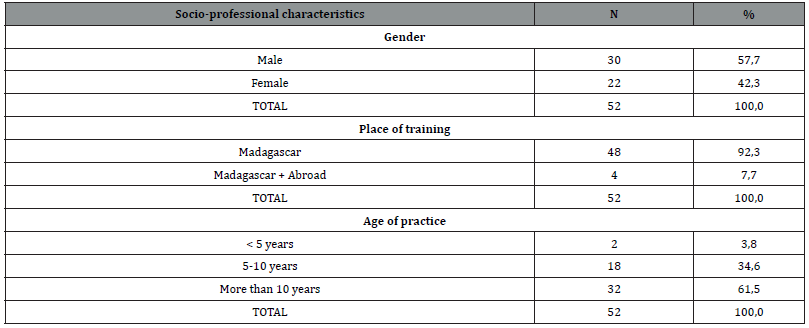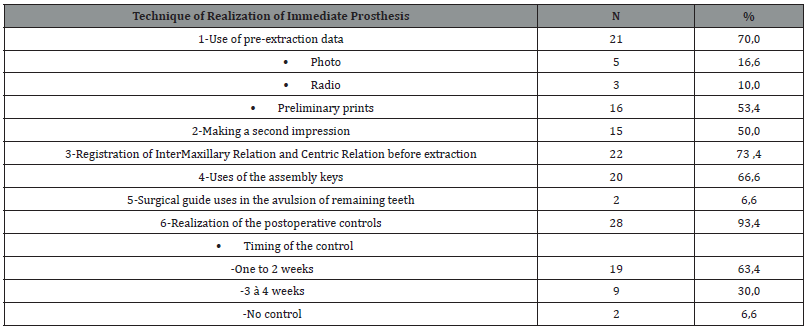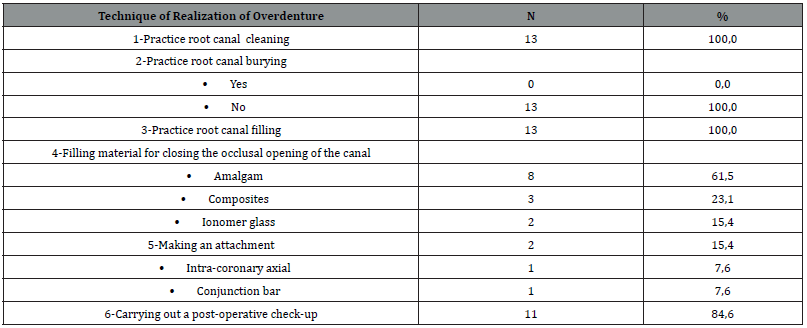 Research Article
Research Article
Care of the Transition from Partial to Total Edentulousness by Odontostomatologists in Mahajanga Madagascar
Naomy Namboarintsoa Ratsimandresy1*, Lova Thierry Fabien2 and Liantsoa Fanja Emmanuel Ralaiarimanana1
1Department of Prosthodontics at Tropical Odonto-Stomatological Institute of Madagascar (IOSTM), University of Madagascar, Madagascar
2Department of Public Health at Tropical Odonto-Stomatological Institute of Madagascar (IOSTM), University of Madagascar, Madagascar
Naomy Namboarintsoa Ratsimandresy, Department of Prosthodontics, at Tropical Odonto-Stomatological Institute of Madagascar (IOSTM), University of Mahajanga, Madagascar.
Received Date:January 23, 2023; Published Date: February 09, 2023
Abstract
Objective: The aim of this study was to identify the practices of the odontostomatologist (OS) in the city of Mahajanga Madagascar during the care of the transition from partial to total edentulousness.
Methodology:A descriptive cross-sectional study on fifty two (52) OS making dental prosthesis in the city of Mahajanga was conducted. The therapeutic choice, the criteria of therapeutic choices and care techniques of the transition from partial to total edentulousness were evaluated.
Results:The results showed that 57.7% of the OS performed immediate denture, 53.8% realized transitional denture, and 25% performed overdenture. Despite these three proposals, 82.7% of the OS still waited for healing after dental avulsion before performing a dental prosthesis.
Suggestions:Continuing education is necessary for the progress and advancement of the profession, in order to improve practices in therapeutic management.
Keywords: Edentulousness; Immediate prosthesis; Transitional prosthesis; Overdenture
Introduction
The transition from partial to total edentulousness is a very delicate clinical stage. It creates a problem for patients because tooth loss constitutes an handicap, equivalent to a disability, both psychologically and functionally with a loss of masticatory efficiency and a decrease in life comfort [1].
In Madagascar, the proportion of denture wearers is still low according to available data. Indeed, in 2016, a study conducted in Fianarantsoa found that among the edentulous people constituting the study population, only 40.7% wore dentures [2].
Currently, patients destined for total edentulousness no longer accept to show their infirmity by remaining edentulous for a longer or shorter time. When the anterior sector is affected by dental extractions, the problem increases and immediate prosthetic restoration is required. It aims, on the one hand, to meet the aesthetic and functional requirements and, on the other hand, to ensure the biological and psychological integration of the prosthesis [3].
Thus, the general objective of this work was to identify the practices of the OS in Mahajanga facing the transition from partial to total edentulousness.
And the specific objectives were to:
-Make an inventory of the means of care of the transition from
partial to total edentulousness by the OS in Mahajanga,
-Identify the criteria of therapeutic choices by the OS for the
care of the transition from partial to total edentulousness,
-Identify the techniques used by the OS to care the transition
from partial to total edentulousness,
-make suggestions for improving the care of the transition from
partial to total edentulousness.
Methodology
The study was conducted in the dental offices of the city of Mahajanga. It is a cross-sectional study. The study was carried out among fifty-two (52) OS practicing in private or public dental offices, making dental prostheses. The study variables were the means of care of the transition from partial to total edentulousness, the criteria for therapeutic choices, and the care techniques for managing the transition from partial to total edentulousness. Data entry and analysis were performed using the Statistical Package for the Social Sciences (SPSS) 20.0 for Windows.
Results
Table 1:Distribution of OS according to socio-professional characteristics.

N: number %: percent
The study population consisted of 52 practitioners with a predominance of males (57.7%). Ninety-two point three percent (92.3%) of the OS had been trained in Madagascar, while 7.7% had been trained both in Madagascar and abroad. According to the year of practice, 34.6% of the OS have been practicing for 5 to 10 years ; 61.5% have been practicing for 10 years or more and finally 3.8% have been working for less than 5 years.
Table 2:Distribution of the OS according to the therapeutic solutions proposed to the patients during the transition from partial to total edentulousness.

Faced with the transition from partial to total edentulousness, different prosthetic solutions were proposed to the patients by the OS: 57.7% of the OS chose the immediate prosthesis, 53.8% preferred the transitional prosthesis and 25% thought of the overdenture. In spite of these three proposals, 82.7% of the OS still waited for healing after the dental avulsion before performing the dental prosthesis.
Table 3:Distribution of the OS according to the therapeutic solutions practiced and the criteria of therapeutic choice.

For the OS who chose the immediate prosthesis as a therapeutic solution for the transition from partial to total edentulousness, 80.0% referred to the number and condition of the remaining teeth; 70.0% considered the clinical condition of the patient; 66.7% valued the time available to the patient for the treatment, 36.7% respected the general condition of the patient and finally 13.3% took into account other criteria such as the profession, the purchasing power of the patients.
For the criteria for proposing the practice of overdenture, 84.6% of the OS practicing overdenture referred to the number and condition of the remaining teeth; 69.2% took into account the time available for the realization of the prosthesis and finally 61.5% referred to the clinical condition of the patient. Regarding the practice of transitional prostheses, 75% of the OS who performed them took into account the number and condition of the remaining teeth, 67.9% took into account the clinical condition of the patient and 60.7% took into account the time available to perform the prosthesis.
Among the OS who made prosthesis after healing, the clinical condition of the patient was of interest to 68.9% of OS; 50.2% of the OS considered the time available for the realization of the prosthesis and 42.1% of OS referred to the number and condition of the remaining teeth.
Table 4:Distribution of the OS practicing immediate prosthesis according to the technique of realization.

Seventy percent (70%) of the OS performing immediate prosthetics used pre-extraction data; 53.4% took a preliminary impression, 16.6% took a photo, and only 10% took the radiograph. Fifty percent (50%) took a secondary impression; 73.4% recorded the Inter Maxillary Relation and Centric Relation; 66.6% used mounting keys, on the other hand, the use of surgical guide during the avulsion of the remaining teeth was done by only 6.6% and 93.4% of the OSs performing immediate prosthesis did a postoperative control.
Table 5:Distribution of the OS practicing overdenture according to the technique of realization.

All OS practising overdenture did root canal cleaning and did not root canal burying, they obturated root canals. For obturation of the root canal opening, amalgam was the most used at 61.5%, followed by composite at 23.1% and finally glass ionomer at 15.4%. And only 15.4% of the OS practicing overdenture performed the attachment, 7.6% performed the axial intra-coronal technique and the same for the conjunction bar. Eighty-four point six percent (84.6%) of the OS performing overdenture did a postoperative check-up.
Table 6:Distribution of the OS according to the technique used to make a transitional prosthesis.

For those who performed transitional prosthesis:
-According to the technique used, 96.4% of the OS took into
account the degree of mobility as a criterion for determining the
number of teeth to be extracted;
-Ninety-two point eight percent (92.8%) followed the total
prosthesis technique and 50.0% adopted the partial prosthesis
technique.
Discussion
> Characteristics of the study population
The study population was predominantly male. This is consistent with the global finding regarding the masculinization of the dental profession [4].
The majority of OS had their training in Madagascar. This result seems logical because the country, more exactly the city of Mahajanga, has a training school in Odonto-Stomatology: the Institute of Tropical Odonto-Stomatology of Madagascar (IOSTM), it is the only school in the entire Indian Ocean. Its layout is an asset for Madagascar.
Considering the proportion of OS according to the age of practice, we can say that the OS in Mahajanga have more years of practice. New graduates prefer to work outside the city of Mahajanga where they have lived throughout their university studies. And when they finish their studies, the first idea that comes to mind is to leave the city.
> Therapeutic solutions for the transition from partial to total edentulousness
Different prosthetic solutions are proposed by the OS for the care of the transition from partial to total edentulousness, such as: the immediate prosthesis, the overdenture, and the transitional prosthesis. According to Hüe [5], the choice between one of these three proposals results from the search for a balance between the specific problems of these therapeutic solutions, the clinical examination, and the fears and hopes of the patient [5].
In spite of these three proposals, there are still OS who have waited for healing after dental avulsion before making the prosthesis. This type of management does not really address the problems of the transition from partial to total edentulousness, which constitutes a handicap, both psychologically and functionally for the patient [1]. The patient must be edentulous for a certain period of time while waiting for healing and must bear all the repercussions of edentulousness during this period. This therapeutic choice can be explained by the lack or absence of training on the possible means of prosthetic management from which, practitioners apply the simple and usual therapeutic means.
> Criteria for therapeutic choices
Regarding the criteria for the therapeutic choice of the immediate prosthesis, the majority of the OS have taken reference to the number and condition of the remaining teeth and the clinical condition of the patient. In fact, this type of prosthesis is indicated in case of reduced extrinsic and intrinsic values of the remaining teeth, in case of very unfavorable clinical crowns, or deficient periodontal supports, or very advanced bone resorption and/or vertical bone resorption [6].
According to the reasons for tooth extraction, the aesthetic order was the first one. It is quite logical because with the immediate prosthesis, the patient is not in a state of discomfort or unaesthetic after his tooth extraction because he is immediately fitted after his tooth avulsion [6].
Problems may arise during the fabrication of an immediate prosthesis, in terms of clinical conditions, patient requirements and expectations, and physiological problems that OS must solve in order to make the patient satisfied [5]. Abdelkoui confirmed that the elaboration of the immediate complete prosthesis of use obeys a rigorous clinical protocol and very specific requirements [3].
Regarding the criteria for the therapeutic choice of the practice of overdenture, the majority of practitioners referred to the number and condition of the remaining teeth, in fact, the indication of the adoption of overdenture as therapeutic management must respect: the value of the remaining teeth (intrinsic and extrinsic value) [7], then the position and number of sufficient teeth; the stabilizing value of the remaining teeth that depends on their situation on the arch in relation to its antagonist [8, 9].
In addition, many of the practitioners took into account the clinical condition of the patient, including the degree of the patient’s oral hygiene. The patient’s non-cooperation on oral hygiene is one of the reasons for not performing overdentures. Indeed, the patient must ensure good oral hygiene as well as good prosthetic hygiene, which can be interrupted by certain conditions such as arthrosis, attitude tremor or parkinsonism [5].
Regarding the criteria for the therapeutic proposal of the
transitional prosthesis, the majority of the OS have taken reference
to the number and condition of the remaining teeth, the clinical
condition of the patient. Indeed, the transitional prosthesis is
indicated in case of:
-A good intrinsic and extrinsic value of the remaining teeth;
-The presence of arches with anatomical elements that do not
favor retention and stabilization,
-Patients with certain clinical situations such as: partial or
total asialia; muscular dyskinesias, neuro-muscular pathologies;
parafunctions (lingual pulses), and others [5].
> Techniques for the management of the transition from partial to total edentulousness
Practice of the immediate prosthesis
In relation to the technique of performing the immediate
prosthesis, the majority of the OS:
-Used pre-extraction data. A rigorous clinical protocol and
specific requirements should be followed to have a good prosthesis
in the aesthetic and functional sense [3]. A good exploitation
of clinical data and pre-extraction documents, which are of
considerable value in terms of shape, dental arrangement as well as
false gingival morphology, gives the means to faithfully reproduce
the existing aesthetics, or even to improve it by extrapolating it in a
reliable way from the indisputable clinical references [5].
-Recorded the InterMaxillary Relation and the Centric Relation;
and used mounting keys. These results correspond well to what
Abdelkoui achieved in therapeutic management with an immediate
prosthesis [3].
On the other hand, less OS used a surgical guide during the avulsion of the remaining teeth, yet a surgical guide which is the exact replica of the prosthesis and which is made of transparent resin, allows to refine the surgical corrections by validating by the prosthetic occlusion the perfect placement of the prosthesis [10].
Practice of overdenture
Depending on the technique used to make the overdenture, all practitioners have performed root canal restoration by closing the root canal opening with amalgam. Amalgam is still the most used material for root canal closure due to its more effective characteristics such as simple and fast processing, easy reconstruction and polishing, good durability and above all its lower cost for the practitioner and the patient [11].
Practice of the transitional prosthesis
Regarding the technique required to fabricate the transitional prosthesis, half of the practitioners have adopted the adjunctive prosthesis technique. The transitional prosthesis has three clinical expressions: the short term, medium term and long term transitional prosthesis. The technique required for each depends on the prognosis of the remaining teeth and the treatment options chosen. When the patient has already been fitted with a denture, it is often possible to perform an addition more or less quickly to replace the extracted teeth. However, if the prosthesis does not meet the criteria for a transitional prosthesis, the prosthetic bases must be readapted at the same time according to the techniques described during the conditioning phase. The medium-term transitional prosthesis is indicated when the patient does not have a partial denture, when the prognosis of the remaining teeth is very poor (high mobility, defective hygiene, major periodontal problems that are difficult to treat), when the patient is not psychologically prepared, or likely in the eyes of the practitioner, to “deal with” total edentulousness. The prosthesis will be made according to the techniques specific to partial resin prostheses, following the usual sequences [5].
In some cases, despite the good intrinsic and extrinsic value of the remaining teeth, the prognosis remains reserved because of the limited number of teeth and their unfavorable position on the arch. In these cases, long-term transitional prostheses with a metal frame are preferable, as they offer evolutionary possibilities [5].
Conclusion
This study focused on the care of the transition from partial to total edentulousness by the OS in Mahajanga. The aim was to identify the practices of the OS face of this problem.
Effective means of managing this problem exist, namely: immediate prosthesis, overdenture and transitional prosthesis. However, they have not been fully adopted by the OS in the city of Mahajanga. However, the situation seems to be improving.
Similar studies in other regions, or in the whole of Madagascar are desirable in order to know the practices of the Malagasy OS faced with the passage from partial to total edentulousness with a view to improving or establishing national strategies on the prosthetic management of edentulous persons.
Acknowledgement
None.
Conflict of Interest
No conflict of interest.
References
- Steele JG, Sanders AE, Slade GD, Allen PF, Lahtis, et al. (2010) How do age and tooth loss affect oral health impacts and quality of life? A study comparing two national samples. Community Dent Oral Epidemiol 32(2): 107-114.
- Ratsimandresy NN, Andriamamimalala MH, Rakotondratsara MA, Ralaiarimanana LFE (2020) Knowledge, attitude and practice of the population of the City of Fianarantsoa towards the replacement of missing teeth. Rosmel (18): 01-10.
- Abdelkoui A, Fajri PL, Amar Benamar A, Abdedine A (2013) The immediate complete prosthesis of use: realization time by time. Clinic 201: 1-10.
- McKay JC, Quiñonez CR (2012) The feminization of dentistry: Implications for the profession. J Can Dent Assoc 78: c1.
- Hüe O, Berteretche MV (2004) Complete prosthesis. Clinical reality-therapeutic solutions. Paris: Quintessence, France.
- Heartwell CM, Salisbury FW (1965) Immediate complete dentition: an evaluation. J Prosthet Dent 15: 615-624.
- Owall B, Kayser A, Carlsson GE (1996) Prosthodontics. Principles and management strategies. London: Mosby-Wolf.
- Langer A (1991) Root-retained overdentures. Part I: Biomechanical and clinical aspects. J Prosthet Dent 66: 784-789.
- Langer Y, Langer A (1992) Root-retained overdentures. Part II: Managing trauma between edentulous ridges and opposing dentition. J Prosthet Dent 67: 77-81.
- Herbout B, Bertrand C, Dupuis V (1997) Immediate complete prosthesis: a clinical case. Clinic 9: 525-529.
- Association report (1998) Dental amalgam: update on safety concerns. JADA 129: 494-503.
-
Naomy Namboarintsoa Ratsimandresy*, Lova Thierry Fabien and Liantsoa Fanja Emmanuel Ralaiarimanana. Care of the Transition from Partial to Total Edentulousness by Odontostomatologists in Mahajanga Madagascar. On J Dent & Oral Health. 6(5): 2023. OJDOH.MS.ID.000647.
-
Odontostomatologist, Dental prosthesis, Dental extractions, Gingival morphology, teeth, Root canal, Immediate prosthesis, Overdenture, Transitional prostheses, Extracted teeth.
-

This work is licensed under a Creative Commons Attribution-NonCommercial 4.0 International License.






